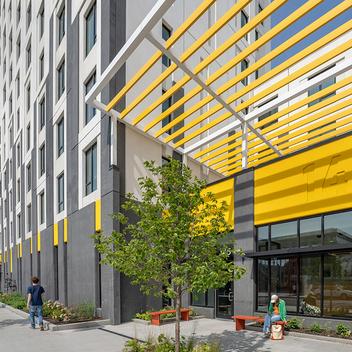In this episode, Phil Thomas, PE, covers helpful information on designing and implementing precast connections into your structure.
Understanding the wide variety of connections and applying this understanding is critical to ensuring a structure's integrity. The topics covered in this video include:
- Types of connections
- Important considerations in selecting connections
- Manufacturing and erection considerations
Types of Connections
Precast connections come in all shapes and sizes. Choosing connections may seem daunting so when you need guidance, it is always helpful to go to the Wells website and look at the Design Handbook. Precast connections can accommodate any construction type, and you will find numerous connection details for common conditions.
Welded Connections
Welded connections are the most common style of connection used in precast concrete construction. Embed plates are fabricated in the precast plant and cast into members. Erection plates are then used in the field once the product is placed to bridge the joint between members and weld them together. Tolerances must be considered in all connection types and welded connections are no exception.
Bolted Connections
Bolted connections are another option and are typically used in cases where glass or other elements near the connection can be damaged from the welding process. Bolted connections can also provide additional tolerance or be used in temporary conditions until a proper welded connection can be made.
Corbel Connections
Corbel connections are integral to precast construction and primarily support gravity load. They can be cast-in concrete style corbels or made from welded steel plates as well.
It is important to keep in mind that there are literally hundreds of custom connections you can create with precast concrete construction. Standard connections are the most efficient and economical. It is always wise to consult with preconstruction and engineering teams early on in a project to determine the best connection method.
Important Considerations in the Selection of Connections
The first thing to consider when designing connections is what it will be used for and the loading it will be subjected to. Understanding the overall load path of the structure will help you analyze the actual applied loads that occur on the connections. Connections can often have several loads applied to them in different directions, so understanding the various load cases is critical. Once you know the loads, selecting a connection that utilizes standard material first is useful if it is adequate for the load. Custom, one-off connections often result in materials with long lead times that are generally more expensive and less efficient.
Environmental factors and exposure of connections should also be considered. Where possible, placing connections in locations that are shielded from weather or thermal effects is desirable.
- In cases where steel connections are subjected to the elements, special finishes can be applied to the steel to reduce corrosion and wear over time.
- Precast concrete members subjected to thermal cycles can create large forces in connections if not appropriately designed to allow for slip.
- Connections used in seismic applications require more attention by code. Proper detailing of connections can be achieved by taking simple steps early on in a project, so it’s important to get your precast partner on board early.
Manufacturing and Erection Considerations
Once you have selected the connection you want to use, consider the production requirements necessary to create the embeds and assemblies. Most steel components comprise anywhere from 36ksi to 50ksi steel parts that come with a standard black finish. If the design calls for a special finish, that material either must either be ordered and shipped directly to the manufacturing facility or shipped out to be finished elsewhere and sent back. An example of this is an embed plate fabricated in the precast facility and sent out to be hot dip galvanized. Projects in highly corrosive environments like a wastewater treatment plants will require special finishes. Be aware that these various finishes are associated with more costs.
Another crucial aspect to consider is how the connection will be installed in the field. This consideration, when addressed early in the design stage, can prevent costly slowdowns later. Field supervisors play a key role in providing practical feedback on what is most feasible for field personnel. Their input, combined with other considerations, directly influences the safety and efficiency of the field crews.
In the end, precast concrete connections are an essential part of the constructability of a precast structure. Before you start your next project, contact Wells for more information to find out if precast is the right solution for your project.
Additional Connection Resources:
Find these resources in our Design Handbook:
- Bearing Connections
- Non-Bearing Connections



